Long before technology provided us with a pocket sized phone where we can store thousands of our favourite tunes, listening to music on the go was often an unreliable and expensive pastime. In this article we outline a condensed history of the long & arduous journey of Man’s mission to unshackle popular music, setting you free to enjoy your latest playlist at the gym. Dance on the beach under the stars. Or irritate your fellow travellers wherever you roam!
The Early Years
Music on the move is by no means a 20th Century invention. In days of old, serfs and jesters were employed by Royal Decree to entertain Kings and Queens on their travels and engagements by playing the popular tunes of the day on a variety of early instruments such as the Lute, the recorder and the Lyre. However, not so for the common man whose exposure to music was a less personal experience and remained routed in street parties, gatherings or theatre performances.
And with no way to record music, this is how it remained for hundreds of years.
1877 – Along comes the Phonograph
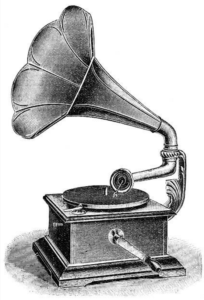
Although it was an amazing innovation at the time, even the invention of the phonograph in the late 19th Century didn’t free recorded music from being a stagnant experience. As many phonographs were unwieldy with a huge horn and weighing up to 300 pounds they were intended purely as home entertainment. Again it was the rich and privileged that were able to employ help to move the system between locations. And with the high cost of the players, recorded music ‘on the move’ remained extremely limited and still largely a pastime of the elite.
On the Road
In 1904, an American inventor, Lee de Forest, demonstrates the first car radio at an Exposition event in St. Louis. It was too early for it to be entirely successful and it wasn’t until 1920 that the valve and transformer technology had progressed to the point where an in-car radio could become a viable everyday accessory.
In 1924, Kelly’s Motors of New South Wales, Australia made history by installing its first car radio.
But it would be another six years before Motorola (yes, the mobile phone pioneers) produced a radio receiver that was marketed in America by GMC. At $130 (approximately a fifth the price of a car), it was still ludicrously expensive and not many of these early models were installed.
In fact it wasn’t until just before WWII in the late 1930’s that push button AM radios were considered a standard feature in a new car. By the end of the war there were an estimated 9 million AM car radios in use. It’s the mid 1940’s and music was on the move!
The 1950’s Revolution
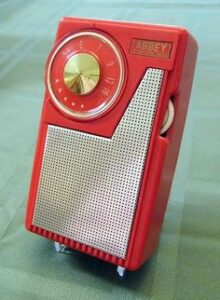
It’s the early 1950’s and portable music takes a giant Quantum leap with the invention of the tiny semiconductor known to one and all as the Transistor. No longer shackled to heavy cumbersome valves, along came tiny radio receivers called transistor radios. The sound was tinny and scratchy and they were prone to picking up static. BUT NOBODY CARED! It was the 50’s. At last, you could listen to your favourite radio station wherever and whenever you liked. It was cool. It was rebellious. It was a revolution.
Of course, the transistor radio had been coming since the late 1940’s. But only ever as prototypes or demonstration models by Sony, RCA and Intermetall of Germany. The first commercially available one was released by Texas Instruments and IDEA of Indianapolis in October 1954.
It was called the Regency TR-1. After a year they had sold 100,000 units, but the reviews of its performance generally focused on the tinny sound of the small speaker.
Cassette for a change
Throughout the 50’s and 60’s, transistor radios became better designed and more accessible, with later models being affordable by the average household. But then in the late 1960’s along came the portable cassette player/recorder and for music on the move, things were set to change.
The cassette player was battery operated, had a reasonably sized speaker and could be listened to in comfort over separate headphones. Unsurprisingly they became very popular, very quickly.
Unlike the portable but bulky 8-track, the cassette player with its user friendly C30/C60/C90 minute cassette format, was the perfect complement to home taping systems like the music centre. At last, you could record your favourite records and radio shows and play them back in the garden, the park or at the beach. By the 1970’s, it was every school kid’s dream come true.
Walk the Walk (man)
So, by now we have the car stereo, we have the transistor radio and we have the 8 track and portable cassette player. Teenagers and parents alike were all using affordable portable music devices wherever and whenever they wanted. But in a few short years, things were about to get much, much better.
Enter Andreas Pavel . A German-Brazilian inventor and former television executive, who devised the Stereobelt in order to, as he put it, ‘add a soundtrack to real life’. The Stereobelt offered high fidelity music through headphones while its wearer was participating in daily activities.
Pavel took his invention around to many of the high end audio companies of the time, most of whom rejected it, mainly on the grounds that people wouldn’t want to wear headphones in public (!)
One of those companies was Sony, who in 1979 came up with the revolutionary Sony Walkman. A miniature cassette player designed to clip onto a belt and listened to on accompanying headphones. (Andreas Pavel, by the way, entered a legal battle with Sony that would last for decades until he was able to claim some of the rights to the German sales of the Walkman, which he claimed was based on his original design).
The Walkman prototype was actually based on a modified Sony Pressman. A compact tape recorder designed for journalists and released 2 years earlier in 1977.
The Sony Walkman was an instant hit and coincided with the trends of jogging and aerobic exercise. Activities that were so much more fun when you were listening to Queen or Abba. Madonna or Bowie. Plus, the Walkman’s 2 AA batteries and headphones added lightweight convenience and privacy to the experience of listening to personal music.
Also arriving on the scene in the mid 1980’s, by way of New York’s burgeoning Hip Hop scene, was the Boombox or Ghetto Blaster. The bigger the better, these hybrid portable music centres focused on volume and clarity of sound, often including tape to tape features and other gimmicks.
So with the Sony Walkman and the Ghetto Blasting Boombox, by the mid 80’s, everyone could afford to take part in this latest accessorised pastime. Listening to music while on the move.
All change for the new format
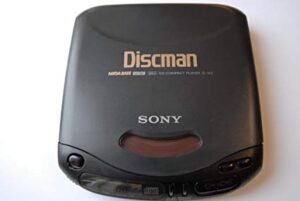
But wait! Aren’t those old cassettes sounding a little hissy these days? A bit muddy? A little woolly?
Isn’t it time for a cleaner, brighter sound?
Compact Discs had been around since the early 1980’s, but became popular and commercially available after the introduction of Sony’s one and only Discman. A portable CD player with extra outputs that you could plug straight into your home system. Perfect for every get-up-and-go Hi-Fi enthusiast. Despite the heavy price tag of early models (hipsters could pay up to $350 in 1984) The Discman once again sparked a revolution in portable music by improving the sound quality of the mobile experience.
Sure, there were other makes of portable cassette players and CD players. But Sony managed to corner the market with early innovation and mass production, which meant that their competitors were constantly wrong footed, finding it hard to catch up with the brand leader. This was Sony’s time to shine and the huge Japanese conglomerate made the most of it with their new slogan, ‘It’s A Sony’.
The Nineties hiatus
And that’s the way it stayed. At least for a few years. Yes, there were other innovations. The Digital Age meant that information could be recorded in good ol’ noughts and ones and we were treated to Minidisc, another Sony invention that had great success in Japan and moderate success in Europe. Digital Audio Tape (DAT), introduced in the late 80’s became a popular format in the music industry and many portable versions were used for field recordings or broadcast quality vox pops (street interviews). Less so for portable recreational music, these two formats were considered pro or semi-pro, though Minidisc picked up a hardcore following of enthusiasts who saw it as the natural successor to the CD.
By the mid 1990’s there was a feeling that something was in the air. But nobody, except the forward thinking futurists and computer geeks, seemed to know what form it would take. Surprisingly, what happened owed a big debt to the past as we were about to find out.
MP Free
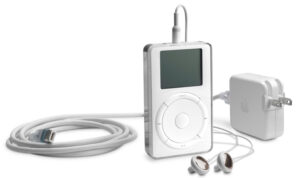
The MPEG3 (Moving Pictures Experts Group layer 3) was an audio format first adopted by movie makers in the 1980’s and using a theory that had been around for donkey’s years. The theory being that the human ear is unable to pick up a number of masked frequencies. So why not strip those frequencies away, thus making the resulting file many times smaller and easier to handle.
This lighter, more accessible format was perfect for use in the fledgling computer/internet market as full bandwidth WAV files took forever to transfer on dial up modems. So, despite the loss of quality, the MP3 was adopted as standard and by the late 90’s, music websites and blogs (Napster, anyone?) began to appear hosting music tracks ripped directly from CD and converted into the MPEG format.
It followed that eventually the public would need portable players to listen to these files away from their computer towers. And so, the MP3 Player was born.
The first mass-produced MP3 player with flash memory included was called the MPMan, developed and manufactured by SaeHan Information Systems. The MPMan was launched in 1998, but was expensive and complicated to use, so it never really took off.
It was followed a few short months later by the Rio PMP300. This was cheaper and had better connectivity. Able to plug directly into a computer it was an instant success.
However, that success was short lived as in 2001 Apple Inc were to release the first ever iPod on an unsuspecting public.
Changing the game
The Apple iPod was an instant game changer in the portable music market. The user could now upload thousands of songs (from Apple’s hugely popular iTunes platform) onto a single device. And, unlike a Discman or the many other portable devices, you could choose specific tracks from albums, building your own playlists to listen to while travelling, or at work, or at the gym, or to play at a party. Suddenly, everyone was a DJ. A music curator. In charge of their listening destiny. More than ever before. This was truly a revolution of huge magnitude.
Other personal music file players were available of course, but Apple ruled the roost and sold millions of players from 2001 onwards, upgrading and updating with version after version as the technology improved.
In 2004, three years after the initial release, the iPod dominated digital music player sales in the USA with over 90% of the market of hard drive based players and 70% of the market of all types of players.
In January 2007, Apple reported quarterly revenue of $7.1 billion of which 48% was made up of iPod sales. That’s a whole lot of people listening to a whole lot of music. And iPods dominated the market for more than a decade. But as this article has proved. In the world of mobile music, nothing stands still forever. A huge shift was on the horizon. And coming up fast.
Get Smart
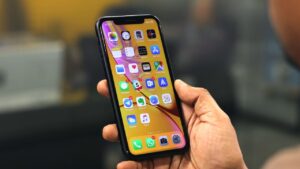
Smart Phones had been lurking around for quite some time. Early prototypes with obscure operating systems had been introduced way back in the 1990s. But a mobile phone that could stream, download and play music? Early on in the millennium that was still pretty much a pipe dream. However, Samsung were the first to innovate with the Samsung SPH-M100 (UpRoar) launched in 2000 and considered to be the first mobile phone to have MP3 music capabilities in the US Market.
The data speeds of competing models would find the large files difficult to manage. Phones in this period concentrated more on their camera technology and other features.
However, Motorola (remember them from the early car radio days?) introduced a flagship Rokr model in 2005 incorporating support of media player features. And it wasn’t long before data speeds improved and new technology and faster connectivity (3G was introduced commercially around 2002/2003) allowed the pipe dream to become a reality. Perhaps now, music’s migration from MP3 player to Smart Phone could begin in earnest.
The final chapter?
Apple once again dominated the market with the release of the iPhone on June 29th, 2007.
Here was a device geared up to multi task and offer accessibility to an Aladdin’s Cave of music from the iTunes store. It had the ability to do so much more than all other portable music devices combined. It was the World leader and turned Apple into one of the World’s most valuable publicly traded companies. As of November 1st 2018, a total of more than 2.2 billion iPhones had been sold, giving a great chunk of the World’s population access to the ultimate portable mobile music playing device.
The future beckons
So here we are. Android and iOS phones offer the perfect solution to listening to portable music. Creating playlists. Streaming. Downloading (and uploading) tracks. What more could we possibly want from a portable music player?
Well, let’s not forget that, despite the rise of music friendly phones, the portable audio player still exists. For instance, check out the Hifiman HM-60X series, The Tera-Player and Sony’s PHA-2. The huge advantage these bad boys have is sound quality. Your average audiophile will chat for hours about the poor quality of lossy audio formats like the MP3. And when you listen to a lossless format at a hugely higher bandwidth, the difference in quality becomes clear.
So perhaps the future lies in a device with all the convenience of a mobile Smartphone, but able to reproduce a faultless studio quality listening experience through full bandwidth wireless earbuds.
Or do we just implant a microchip at birth and beam it all down from the Moon?
Perhaps they’re working on that right now. Let’s hope so!
Simon Power is a sound designer & composer for BBC’s Doctor Who audio dramas. He is signed to Banco De Gaia’s Disco Gecko record label and as Dream Valley Music, composes for films, TV and games.




